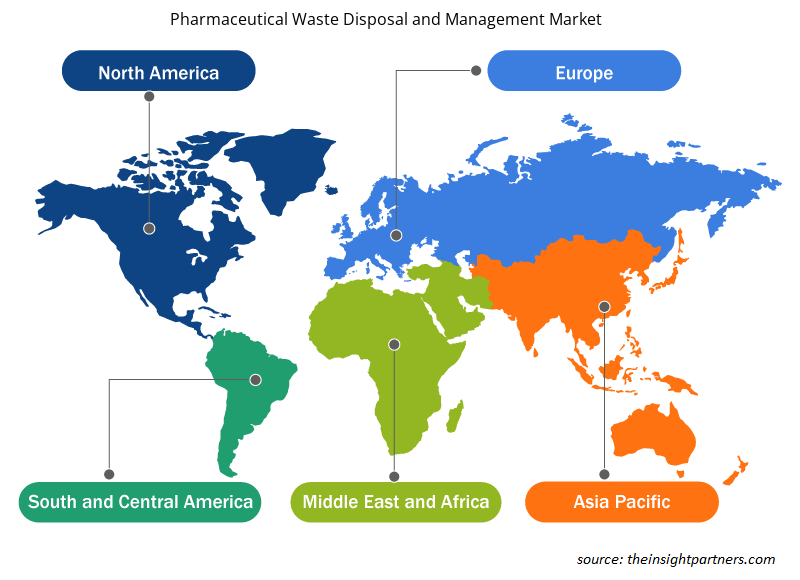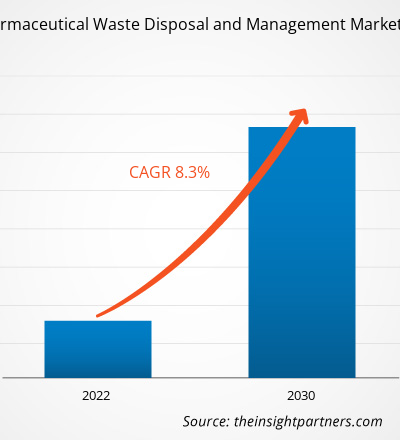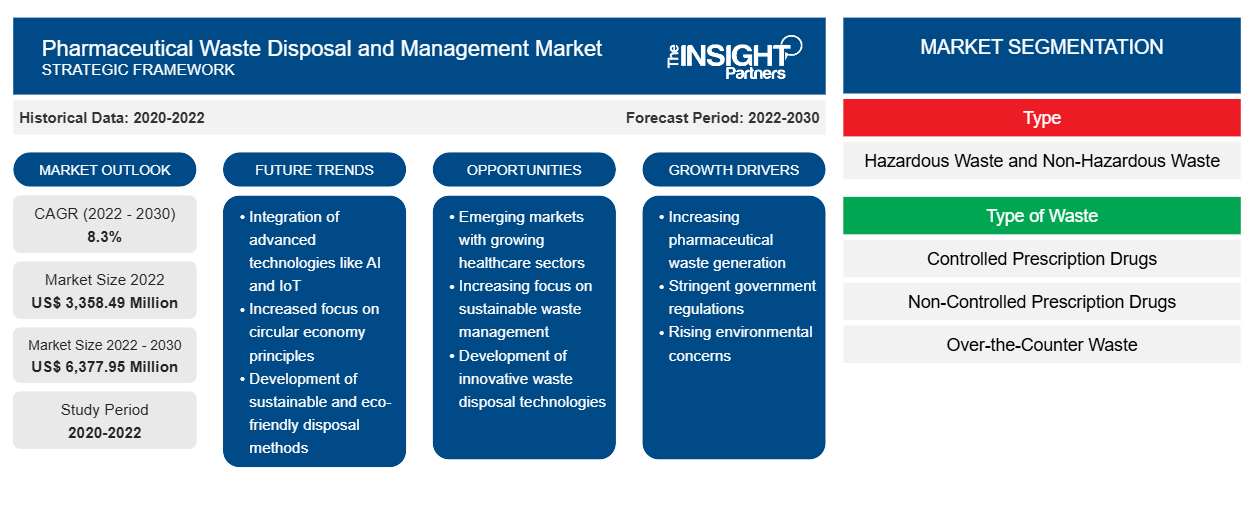[Forschungsbericht] Der Markt für die Entsorgung und das Management pharmazeutischer Abfälle soll von 3.358,49 Millionen US-Dollar im Jahr 2022 auf 6.377,95 Millionen US-Dollar im Jahr 2030 wachsen; von 2022 bis 2030 wird eine durchschnittliche jährliche Wachstumsrate (CAGR) von 8,3 % erwartet.
Markteinblicke und Analystenansichten:
Pharmazeutische Abfälle umfassen unbenutzte Produkte oder Medikamente, deren Verfallsdatum überschritten ist. Diese Abfälle können aufgrund ihrer chemischen Zusammensetzung als gefährlich oder ungefährlich eingestuft werden. Die Einstufung von Medikamenten als pharmazeutische Abfälle basiert auch darauf, ob sie ein Risiko für die öffentliche Gesundheit oder die Umwelt darstellen. Pharmazeutische Abfälle umfassen auch Restmaterialien aus ihren Herstellungsprozessen und rezeptfreie Arzneimittel sowie verschreibungspflichtige Medikamente, die aus den zuvor genannten Gründen übrig bleiben. Zu den wichtigsten Faktoren, die das Wachstum des Marktes für die Entsorgung und das Management von pharmazeutischen Abfällen vorantreiben , gehören zunehmende staatliche Initiativen zur Förderung der ordnungsgemäßen Entsorgung von medizinischen Abfällen und ein steigendes Bewusstsein für pharmazeutische Abfälle. Die mit der Entsorgung von pharmazeutischen Abfällen verbundenen hohen Kosten behindern jedoch das Marktwachstum.
Wachstumstreiber und -hemmnisse:
Krankenhäuser, Kliniken und andere Gesundheitseinrichtungen produzieren große Abfallmengen. Die staatlichen Bemühungen, die ordnungsgemäße Entsorgung von medizinischem Abfall zu erleichtern, haben in den letzten Jahren erheblich zugenommen, da eine unsachgemäße Handhabung und Entsorgung ein zunehmendes Risiko für die menschliche Gesundheit und die Umwelt darstellt. Der Ausbau der Gesundheitseinrichtungen und ein Anstieg der Produktion von medizinischem Abfall sind zwei Hauptfaktoren, die zur gestiegenen Nachfrage nach Produkten und Dienstleistungen zur Entsorgung und Handhabung von medizinischem Abfall beitragen. Mehrere Regierungen haben Schritte unternommen, um die mit medizinischem Abfall verbundenen Probleme in den Griff zu bekommen, indem sie Gesetze und Richtlinien erlassen haben, die eine sichere und ordnungsgemäße Entsorgung von medizinischem Abfall gewährleisten. Medizinischer Abfall muss im Allgemeinen ordnungsgemäß entsorgt und gemäß diesen Regeln verpackt, transportiert, behandelt und getrennt werden. In den USA haben Behörden wie die Centers for Disease Control and Prevention (CDC), die Occupational Safety and Health Administration (OSHA) und die US Food and Drug Administration (FDA) Vorschriften für medizinischen Abfall erlassen. Titel 49 CFR ist eine Bundesverordnung, die sich auf Vorschriften, Sammlung und Entsorgungsprozesse für medizinischen Abfall konzentriert, und 49 CFR 173.197 konzentriert sich auf regulierten medizinischen Abfall.
Andererseits sind die hohen Kosten des gesamten Entsorgungsprozesses ein Hauptproblem für Unternehmen, die pharmazeutische Abfälle entsorgen und verwalten, und betreffen Pharmahändler, Gesundheitseinrichtungen und Abfallentsorgungsdienstleister. Jeder Schritt des Entsorgungsprozesses ist mit hohen Kosten verbunden, einschließlich angemessener Abfallverpackung, Trennung, Transport, Behandlung, Papierkram und Einhaltung von Vorschriften. Darüber hinaus sind die hohen Kosten für die Entsorgung pharmazeutischer Abfälle auf die Umsetzung spezieller Protokolle, die Einhaltung gesetzlicher Vorschriften und die Anforderung nachhaltiger und ethischer Abfallbewirtschaftungstechniken zurückzuführen.
Passen Sie diesen Bericht Ihren Anforderungen an
Sie erhalten kostenlos individuelle Anpassungen an jedem Bericht, einschließlich Teilen dieses Berichts oder einer Analyse auf Länderebene, eines Excel-Datenpakets sowie tolle Angebote und Rabatte für Start-ups und Universitäten.
-
Holen Sie sich die wichtigsten Markttrends aus diesem Bericht.Dieses KOSTENLOSE Beispiel umfasst eine Datenanalyse von Markttrends bis hin zu Schätzungen und Prognosen.
Berichtssegmentierung und -umfang:
Der globale Markt für die Entsorgung und das Management von Arzneimittelabfällen ist nach Art, Abfallart und Anwendung segmentiert. Nach Art wird der Markt für die Entsorgung und das Management von Arzneimittelabfällen in gefährliche Abfälle und ungefährliche Abfälle unterteilt. Nach Abfallart wird der Markt für die Entsorgung und das Management von Arzneimittelabfällen in kontrollierte verschreibungspflichtige Medikamente, nicht kontrollierte verschreibungspflichtige Medikamente und rezeptfreie Abfälle unterschieden. Nach Anwendung wird der Markt in Gesundheitseinrichtungen, Apotheken, Pharma- und Biotechnologieunternehmen und andere segmentiert. Der Markt für die Entsorgung und das Management von Arzneimittelabfällen ist geografisch in Nordamerika (USA, Kanada und Mexiko), Europa (Deutschland, Frankreich, Italien, Großbritannien, Russland und Rest von Europa), Asien-Pazifik (Australien, China, Japan, Indien, Südkorea und Rest von Asien-Pazifik), Naher Osten und Afrika (Südafrika, Saudi-Arabien, Vereinigte Arabische Emirate und Rest von Nahem Osten und Afrika) und Süd- und Mittelamerika (Brasilien, Argentinien und Rest von Süd- und Mittelamerika) segmentiert.
Segmentanalyse:
Der Markt für die Entsorgung und das Management von pharmazeutischen Abfällen ist nach Typ in gefährliche Abfälle und ungefährliche Abfälle unterteilt. Das Segment der ungefährlichen Abfälle hatte 2022 einen größeren Marktanteil. Es wird jedoch erwartet, dass das Segment der gefährlichen Abfälle zwischen 2022 und 2030 eine höhere durchschnittliche jährliche Wachstumsrate verzeichnet.
Der Markt für die Entsorgung und das Management von Arzneimittelabfällen ist nach Abfallart in kontrollierte verschreibungspflichtige Arzneimittel, nicht kontrollierte verschreibungspflichtige Arzneimittel und rezeptfreie Abfälle unterteilt. Das Segment der nicht kontrollierten verschreibungspflichtigen Arzneimittel hatte 2022 den größten Marktanteil. Es wird erwartet, dass es von 2022 bis 2030 die höchste durchschnittliche jährliche Wachstumsrate verzeichnet.
Der Markt für die Entsorgung und das Management von Arzneimittelabfällen ist nach Anwendung in Gesundheitseinrichtungen, Apotheken, Pharma- und Biotechnologieunternehmen und andere unterteilt. Im Jahr 2022 hatte das Segment der Pharma- und Biotechnologieunternehmen den größten Marktanteil. Es wird erwartet, dass das Segment zwischen 2022 und 2030 die höchste durchschnittliche jährliche Wachstumsrate verzeichnet. CAGR during 2022–2030.
Regionale Analyse:
Geografisch ist der globale Markt für die Entsorgung und das Management pharmazeutischer Abfälle in fünf Schlüsselregionen unterteilt: Nordamerika, Europa, Asien-Pazifik, Süd- und Mittelamerika sowie Naher Osten und Afrika.Im Jahr 2022 hatte Nordamerika den größten Marktanteil. Der Markt in Nordamerika spiegelt eine komplexe Landschaft wider, die von strengen Vorschriften, fortschrittlichen Abfallmanagementtechnologien und einem Engagement für den Umweltschutz geprägt ist. Gesetze wie der US Resource Conservation and Recovery Act (RCRA) und der Canadian Environmental Protection Act (CEPA) legen verbindliche Protokolle für die sichere Handhabung und Entsorgung von pharmazeutischen Abfällen fest und überwachen anschließend deren Einhaltung, was dem Wachstum des Marktes für die Entsorgung und das Management von pharmazeutischen Abfällen zugutekommt.RCRA) and the Canadian Environmental Protection Act (CEPA) roll out the mandatory protocols for the safe handling and disposal of pharmaceutical waste, followed by monitoring adherence to the same, which benefits the pharmaceutical waste disposal and management market growth.
Branchenentwicklungen und zukünftige Chancen:
Nachfolgend sind verschiedene Initiativen wichtiger Akteure auf dem globalen Markt für die Entsorgung und das Management pharmazeutischer Abfälle aufgeführt:
- Im November 2023 vereinbarte Sumitomo Pharma Co., Ltd. eine Zusammenarbeit mit ORIX Eco Services Corporation im Rahmen einer Initiative zum Recycling von Blisterverpackungsabfällen, die im Verpackungsprozess für von Sumitomo Pharma hergestellte verschreibungspflichtige Arzneimittel anfallen.
- Im Mai 2023 erhielt ORIX Eco Services als erstes Unternehmen in Japan eine Lizenz zur industriellen Abfallentsorgung für die Entfernung von Blisterverpackungsabfällen und anderen Materialien. Die Blisterverpackung wird für die Verpackung verschreibungspflichtiger Arzneimittel verwendet, und der bei diesem Verfahren entstehende Abfall wurde zuvor verbrannt.
- Im April 2022 kündigte Stericycle Inc. seine neue SafeShield-Reihe hochwertiger, standardisierter Behälter an. Diese antimikrobiellen medizinischen Abfallbehälter sind speziell für die Lagerung und den Transport regulierter medizinischer Abfälle (RMW) konzipiert. Diese Behälter bieten Kunden bessere Lagermöglichkeiten, ein verbessertes Design und ein zusätzliches Maß an Schutz, um mikrobielles Wachstum auf RMW-Behältern zu verhindern. Stericycle hat zuvor mit der Einführung der Behälter in ausgewählten Märkten in den USA begonnen, nachdem eine schrittweise nationale Einführung geplant war.
- Im Februar 2022 erwarb Republic Services Inc. US Ecology, um seine Präsenz in den USA und Kanada auszuweiten. US Ecology ist ein führender Anbieter von Umweltlösungen für die Behandlung, das Recycling und die Entsorgung von gefährlichen, ungefährlichen und Sonderabfällen.
- Im Oktober 2020 erwarb Waste Management Inc. Advanced Disposal, um seine Reichweite zu erweitern. Darüber hinaus plante Waste Management, die Kapazität von Advanced Disposal zu nutzen, um etwa 3 Millionen neue gewerbliche, industrielle und private Kunden in den USA zu bedienen.
Regionale Einblicke in den Markt für die Entsorgung und das Management pharmazeutischer Abfälle
Die regionalen Trends und Faktoren, die den Markt für die Entsorgung und das Management von Arzneimittelabfällen während des gesamten Prognosezeitraums beeinflussen, wurden von den Analysten von Insight Partners ausführlich erläutert. In diesem Abschnitt werden auch die Marktsegmente und die Geografie für die Entsorgung und das Management von Arzneimittelabfällen in Nordamerika, Europa, im asiatisch-pazifischen Raum, im Nahen Osten und Afrika sowie in Süd- und Mittelamerika erörtert.

- Erhalten Sie regionale Daten zum Markt für die Entsorgung und das Management pharmazeutischer Abfälle
Umfang des Marktberichts zur Entsorgung und Verwaltung pharmazeutischer Abfälle
| Berichtsattribut | Details |
|---|---|
| Marktgröße im Jahr 2022 | 3.358,49 Millionen US-Dollar |
| Marktgröße bis 2030 | 6.377,95 Millionen US-Dollar |
| Globale CAGR (2022 - 2030) | 8,3 % |
| Historische Daten | 2020-2022 |
| Prognosezeitraum | 2022–2030 |
| Abgedeckte Segmente |
Nach Typ
|
| Abgedeckte Regionen und Länder |
Nordamerika
|
| Marktführer und wichtige Unternehmensprofile |
|
Marktteilnehmerdichte bei der Entsorgung und Verwaltung pharmazeutischer Abfälle: Auswirkungen auf die Geschäftsdynamik verstehen
Der Markt für die Entsorgung und das Management von Arzneimittelabfällen wächst rasant. Dies wird durch die steigende Nachfrage der Endverbraucher aufgrund von Faktoren wie sich entwickelnden Verbraucherpräferenzen, technologischen Fortschritten und einem größeren Bewusstsein für die Vorteile des Produkts vorangetrieben. Mit der steigenden Nachfrage erweitern Unternehmen ihr Angebot, entwickeln Innovationen, um die Bedürfnisse der Verbraucher zu erfüllen, und nutzen neue Trends, was das Marktwachstum weiter ankurbelt.
Die Marktteilnehmerdichte bezieht sich auf die Verteilung von Firmen oder Unternehmen, die in einem bestimmten Markt oder einer bestimmten Branche tätig sind. Sie gibt an, wie viele Wettbewerber (Marktteilnehmer) in einem bestimmten Marktraum im Verhältnis zu seiner Größe oder seinem gesamten Marktwert präsent sind.
Die wichtigsten Unternehmen auf dem Markt für die Entsorgung und das Management pharmazeutischer Abfälle sind:
- Stericycle, Inc.
- Clean Harbors, Inc
- WM Intellectual Property Holdings, LLC
- Veolia
- BioMedical Waste Solutions, LLC.
Haftungsausschluss : Die oben aufgeführten Unternehmen sind nicht in einer bestimmten Reihenfolge aufgeführt.

- Überblick über die wichtigsten Akteure auf dem Markt für die Entsorgung und das Management pharmazeutischer Abfälle
Wettbewerbslandschaft und Schlüsselunternehmen:
Stericycle Inc, Clean Harbors Inc, WM Intellectual Property Holdings LLC, Veolia, BioMedical Waste Solutions LLC, Daniels Sharpsmart Inc, US Ecology Inc, Stryker, Cardinal Health und MedWaste Management gehören zu den führenden Akteuren auf dem Markt für die Entsorgung und das Management von pharmazeutischen Abfällen. Diese Unternehmen konzentrieren sich auf die Entwicklung bestehender Produkte und die Ausweitung ihrer geografischen Präsenz, um der wachsenden weltweiten Verbrauchernachfrage gerecht zu werden.
- Historische Analyse (2 Jahre), Basisjahr, Prognose (7 Jahre) mit CAGR
- PEST- und SWOT-Analyse
- Marktgröße Wert/Volumen – Global, Regional, Land
- Branchen- und Wettbewerbslandschaft
- Excel-Datensatz
Aktuelle Berichte
Verwandte Berichte
Erfahrungsberichte
Grund zum Kauf
- Fundierte Entscheidungsfindung
- Marktdynamik verstehen
- Wettbewerbsanalyse
- Kundeneinblicke
- Marktprognosen
- Risikominimierung
- Strategische Planung
- Investitionsbegründung
- Identifizierung neuer Märkte
- Verbesserung von Marketingstrategien
- Steigerung der Betriebseffizienz
- Anpassung an regulatorische Trends























 Kostenlose Probe anfordern für - Markt für die Entsorgung und das Management pharmazeutischer Abfälle
Kostenlose Probe anfordern für - Markt für die Entsorgung und das Management pharmazeutischer Abfälle